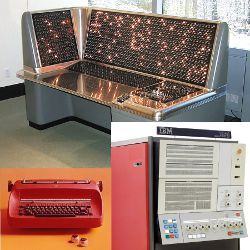
"Much of the thinking, designing, and innovating that went into the development of computers and long-distance electronic communication happened right here in New York," says Louise Mirrer, president and CEO of the New York Historical Society (NYHS). That premise is explored in "Silicon City: Computer History Made in New York," an exhibit that runs through April 17, 2016 at NYHS on Manhattan’s West 77th Street.
The New York City underpinnings of computing technology are displayed in photographs, videos, placards, and hardware; in fact, plenty of hardware, some ready for hands-on action. A plugboard from an early Univac system is a Jackson Pollock tangle of wires (do not touch). An IBM System/360, forerunner of today’s general-purpose computer whose role is recast by software (hands off), sits around the corner from two IBM Selectric typewriters (pound away), and across from a Space Invaders arcade console (fire!). The Jeopardy! booth where Ken Jennings was humbled by IBM’s Watson supercomputer stands down the hall; a Telstar 1 satellite hangs overhead.
New York’s history of computing predates that of Silicon Valley, let alone the iconic Apple Store on Fifth Avenue, by decades. Transistor developer Bell Telephone Laboratories operated the largest industrial research facility in the U.S. in a 13-building complex on the lower west side through the early 20th century. Corporate power IBM was headquartered on Madison Avenue until 1963. Brookhaven National Laboratory developed an early videogame on Long Island. Silicon Valley sprang from this and other groundwork. "Things happened here, then started to go west," says Stephen Edidin, organizer of the Silicon City exhibit and chief curator of the NYHS Museum Division.
The exhibit presents an overview and close-ups. A connection is traced from Thomas Edison’s light bulb, through the "Edison effect" – the inventor’s observation that electrons in a vacuum flow from a heated filament to a cooler foil plate, but not vice versa – to the vacuum tube, the basis of all electronic systems up to the transistor.
Women’s contributions to early computing are also noted. "Many of the early programmers – they were actually called computers – were women," Edidin says. "The idea of who is in the workforce was radically different when we start dealing with computerization. That’s part of this whole New York story."
New York’s art and design worlds had their hands in the advertisements and logos that connected design with computer branding and marketing, the template for tech today. Evidence on display includes Paul Rand’s Eye-Bee-M word puzzle and his familiar IBM eight-bar logo.
IBM is a large presence in "Silicon City." The exhibit’s opening section evokes the IBM Pavilion of the 1964 New York World’s Fair. The company’s mainframes, magnetic tape, personal computer, and Watson (named for pater et filius who served as successive chairmen and CEOS), are all featured. The exhibit was developed "with the generous cooperation of IBM," NYHS says.
Video art is viewable under a geodesic dome. Computerized music, primitive by any measure, is also available. Coding classes for New York City students are part of the "Silicon City" education programs, thanks to Google.org. The goal of the classes match those of the exhibit, and of NYHS itself. "You don’t repeat history," Edidin says. "You learn history first, and then you innovate."
All "Silicon City" images, text, and multiscreen video presentations have been digitized, opening the door to the exhibit’s future presentation. "It could live online," says research associate Cristian Panaite, although no plans for an online presentation have been announced.
David Roman is Web Editor of Communications.



Join the Discussion (0)
Become a Member or Sign In to Post a Comment